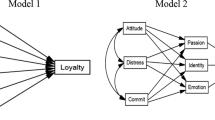Abstract
This chapter is designed to conclusively reflect on the present volume. I would like, first, to make a number of observations on the directions of the research in the field under investigation. Then, I will identify what I see as a common challenge in nearly all of the chapters included in this volume. Finally, I would like to suggest different ways how to meet that challenge by pointing to a singular phenomenon spanning across space and time. I will argue that since the early modern period, nation states have framed the struggle for prestige and influence in an increasingly consumerist way based on mechanisms drawn from advertising. In this context, music has played a central role. The concept of “musical Nation branding,” I suggest, may be useful to grasp this development.
Access this chapter
Tax calculation will be finalised at checkout
Purchases are for personal use only
Similar content being viewed by others
Notes
- 1.
Rebekah Ahrendt, Marc Ferraguto and Damien Mahiet, Music and Diplomacy: For the Early Modern Era to Present (Palgrave Macmillan, 2014).
- 2.
Ronald Radano and Tejumola Olaniyan (eds), Audible Empire: Music, Global Politics, Critique (Durham: Duke University Press, 2016); Bob White (ed.), Music and Globalization: Critical Encounters (Bloomington, Ind.: University of Indiana Press, 2011).
- 3.
Mindy Clegg, “When Jazz Was King: Selling Records With the Cold War,” Journal of American Culture 38 (September 2015): 243–54.
- 4.
Kendra Salois, “The U.S. State Department’s Hip Hop Diplomacy in Morocco,” in Ahrendt et al., “Music and Diplomacy, pp. 231–249.
- 5.
For a review, see Jessica Gienow-Hecht, “Sonic History or Why Music Matters in International History,” in Jessica Gienow-Hecht (ed.), Music and International History (New York, Oxford: Berghahn Books, 2015), pp. 1–30.
- 6.
Anthony Grégoire, “Musical Power and East-West International Diplomacy,” Anthropology News, 19 April 2017, http://www.anthropology-news.org/?book-review=musical-power-and-east-west-international-diplomacy (accessed 24 May 2017).
- 7.
Gienow-Hecht, “Sonic History,” p. 20.
- 8.
Grégoire, “Musical Power.”
- 9.
Ahrendt et al., Music and Diplomacy, p. 3.
- 10.
Danielle Fosler-Lussier, “Music’s Powers,” in Ahrendt et al., Music and Diplomacy, pp. 267–75.
- 11.
Call for papers for the conference “Sounds and Voice on the International Stage,” Paris, 20/21 April 2016.
- 12.
I am indebted to Bill McAllister for this point.
- 13.
Jessica Gienow-Hecht, “The World is Ready to Listen: Symphony Orchestras and the Global Performance of America,” Diplomatic History 36 (1) (January 2012): 17–28.
- 14.
L. H. Teslik, “Nation branding Explained,” Diplomacy and Statecraft / Council on Foreign Relations (9 November 2007), http://www.cfr.org/diplomacy-and-statecraft/nation-branding-explained/p14776 (accessed 12 March 2014).
- 15.
Jessica Gienow-Hecht, “Nation branding,” in Michael Hogan and Frank Costigliola (eds.), Explaining the History of American Foreign Relations, (New York: Cambridge University Press, 2016), pp. 232–244; Melissa Aronczyk, Branding the Nation: The Global Business of National Identity (New York: Oxford University Press, 2013); Nadja Kaneva (ed.), Branding Post-Communist Nations: Marketing National Identities in the ‘New’ Europe (New York: Routledge, 2012); Keith Dinnie, Nation branding: Concepts, Issues, Practice, 2nd ed. (London, New York: Routledge, 2016).
- 16.
Chaitanya Tupaki Sreepoorna, “Bhutan’s Soft Power,” research paper, Paris School of International Affairs, Sciences Po, 7 May 2017.
- 17.
Hillard von Thiessen (ed.), Akteure der Außenbeziehungen: Netzwerke und Interkulturalität im historischen Wandel (Cologne: Böhlau, 2010).
- 18.
Krisztina Lajosi, “National Stereotypes and Music,” Nations and Nationalism 20 (4) (October 2014): 628–645, http://onlinelibrary.wiley.com/doi/10.1111/nana.12086/full (accessed 29 May 2017).
- 19.
Gienow-Hecht, Sound Diplomacy: Music and Emotions in Transatlantic Relations (Chicago: University of Chicago Press, 2009), Chap. 3.
- 20.
Holger Stunz, Die Welt zu Gast in Wiesbaden: Internationale Maifestspiele 1945 bis 1968 (Frankfurt a.M.: Waldemar Kramer, 2008); Sven Oliver Müller, Richard Wagner und die Deutschen: Eine Geschichte von Hass und Hingabe (Munich: Beck, 2013); Sven Oliver Müller and Lutz Raphael (eds), Demarcation and Exchange. “National” Music in 19th Century Europe, special issue, Journal of Modern European History 5 (2007/1).
- 21.
Gienow-Hecht, “The World Is Ready to Listen.”
- 22.
Tom Wolf, “Radical Chic: That Party at Lenny’s,” New York Magazine, 8 January 1970, accessed 24 May 2017. On controversial musicians crossing national borders, see Dorian Lynskey, 33 Revolutions per Minute: A History of Protests Songs, from Billie Holiday to Green day (New York: Harper Collins, 2011), Björn Horgby and Frederik Nilsson (eds), Rocking’ the Borders: Rock Music and Social, Cultural and Political Change (Cambridge: Cambridge Scholars Pub., 2010); John Stratton, When Music Migrates: Crossing British and European Racial Faultlines, 1945–2010 (Farnham: Ashgate, 2014). On music and conflict resolution, see Olivier Urbain (ed), Music and Conflict Transformation: Harmonies and Dissonances in Geopolitics (New York: I.B. Tauris, 2008); John Morgan O’Connel and Salwa El-Shawan Castelo-Branco (eds), Music and Conflict (Urbana, Ill.: The University of Illinois Press, 2010).
- 23.
Thierry Hillériteau, “Un orchestre classique de Corée du Nord à Paris,” Le Figaro, 15 March 2012, http://www.lefigaro.fr/musique/2012/03/15/03006-20120315ARTFIG00782-un-orchestre-classique-de-coree-du-nord-a-paris.php, (accessed 24 May 2017).
Author information
Authors and Affiliations
Editor information
Editors and Affiliations
Rights and permissions
Copyright information
© 2018 The Author(s)
About this chapter
Cite this chapter
Gienow-Hecht, J.C.E. (2018). Of Dreams and Desire: Diplomacy and Musical Nation Branding Since the Early Modern Period. In: Ramel, F., Prévost-Thomas, C. (eds) International Relations, Music and Diplomacy . The Sciences Po Series in International Relations and Political Economy. Palgrave Macmillan, Cham. https://doi.org/10.1007/978-3-319-63163-9_12
Download citation
DOI: https://doi.org/10.1007/978-3-319-63163-9_12
Published:
Publisher Name: Palgrave Macmillan, Cham
Print ISBN: 978-3-319-63162-2
Online ISBN: 978-3-319-63163-9
eBook Packages: Political Science and International StudiesPolitical Science and International Studies (R0)



